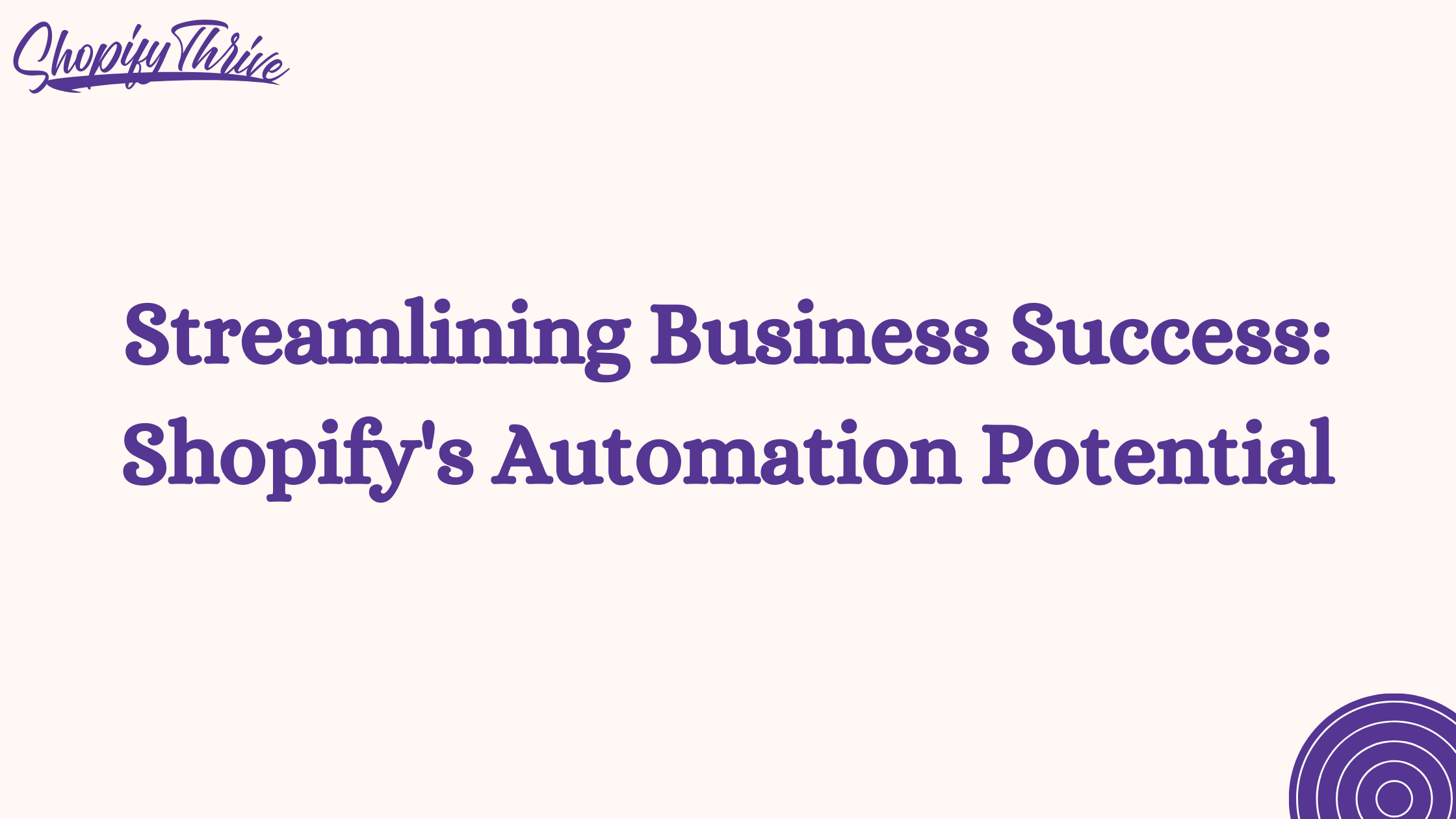
Noor
Streamlining Business Success: Shopify’s Automation Potential
- June 20, 2023
- , 5:41 pm
- , Shopify Tips
1. Introduction
Shopify is an incredibly powerful e-commerce platform that enables entrepreneurs to automate various aspects of their online businesses. By harnessing the extensive automation capabilities offered by Shopify, you can streamline your workflows, save time, and ultimately boost your overall productivity. In this comprehensive guide, we will delve into the various ways you can use Shopify to automate your business, covering essential topics such as setting up automated workflows, utilizing apps for task automation, and effectively outsourcing tasks to freelancers.
2. Setting Up Automated Workflows
Automated workflows are a key component of leveraging Shopify’s automation features. These workflows allow you to streamline repetitive tasks, ensuring efficiency and consistency throughout your business operations. Here are some steps to help you set up effective automated workflows:
- Identify Repetitive Tasks: Begin by identifying tasks that are performed regularly and require minimal decision-making. These tasks are prime candidates for automation.
- Map Out the Workflow: Create a visual representation or flowchart of your workflow, outlining each step and decision point. This will help you identify potential areas for automation.
- Utilize Shopify Automation Tools: Shopify offers a variety of built-in automation tools, such as the Flow and Launchpad apps. Explore these tools and leverage their functionalities to automate tasks like order processing, inventory management, and customer notifications.
- Integrate Third-Party Apps: If Shopify’s built-in automation tools don’t fully meet your requirements, consider integrating third-party apps from the Shopify App Store. There are numerous apps available that cater to specific automation needs, such as email marketing automation, social media posting, and more.
- Test and Refine: After setting up your automated workflows, thoroughly test them to ensure they function as intended. Continuously monitor and refine your workflows to optimize their performance over time.
3. Utilizing Apps for Task Automation
In addition to Shopify’s native automation tools, the Shopify App Store provides a vast array of apps designed to automate specific tasks and enhance your business operations. Here are some key areas where apps can significantly contribute to task automation:
Inventory Management
Efficiently managing your inventory is crucial for a successful e-commerce business. Shopify offers a range of apps that can automate various aspects of inventory management, including:
- Inventory Tracking: Apps like Stocky and TradeGecko help you monitor stock levels, track product variants, and receive automated notifications when inventory levels run low.
- Automated Reordering: With apps such as Orderhive and Ecomdash, you can set up rules to automatically reorder products when inventory reaches a specified threshold.
Order Processing and Fulfillment
Processing orders swiftly and accurately is essential to providing a seamless customer experience. Shopify apps can automate different stages of order processing and fulfillment, including:
- Order Tracking: Apps like AfterShip and Trackr can automate the tracking and status updates for customer orders, reducing manual effort and improving transparency.
- Print-on-Demand: Utilize print-on-demand apps such as Printful and Printify to automate the printing, packaging, and shipping of custom-designed products, eliminating the need for manual handling.
Customer Support and Engagement
Building strong customer relationships is vital for the long-term success of your business. Shopify apps can help automate customer support and engagement, improving efficiency and responsiveness. Consider the following automation possibilities:
- Chatbots: Implement chatbot apps like Tidio or Gobot to automate initial customer interactions, answer common inquiries, and provide personalized recommendations.
- Automated Email Marketing: Take advantage of email marketing automation apps such as Klaviyo or Omnisend to send targeted emails, abandoned cart reminders, and personalized product recommendations based on customer behavior.
4. Outsourcing Tasks to Freelancers
Outsourcing certain tasks to freelancers can be an effective way to leverage Shopify’s automation features while focusing on core business activities. By delegating repetitive or time-consuming tasks, you can free up your own time and resources. Here are some steps to successfully outsource tasks:
- Identify Suitable Tasks: Determine which tasks can be easily delegated to freelancers without compromising quality. Examples include graphic design, content creation, product descriptions, and data entry.
- Define Clear Instructions: Clearly communicate your expectations, guidelines, and deadlines to freelancers to ensure smooth collaboration. Utilize project management tools like Trello or Asana to facilitate communication and task tracking.
- Find Freelancers: Utilize freelancing platforms such as Upwork or Fiverr to find qualified professionals with relevant experience. Review their portfolios and consider previous client feedback to make informed decisions.
- Monitor and Provide Feedback: Regularly review the progress of outsourced tasks and provide constructive feedback to ensure alignment with your expectations. Maintaining open lines of communication is essential for successful outsourcing.
By leveraging Shopify’s automation features and outsourcing tasks to freelancers, you can create a well-optimized and streamlined e-commerce business. Implementing automated workflows, utilizing task-specific apps, and effectively delegating tasks will enable you to save time, reduce manual effort, and focus on scaling your business for long-term success.
5. Conclusion
In conclusion, Shopify provides a robust platform for automating your business operations and maximizing productivity. By harnessing the power of automated workflows, leveraging task-specific apps, and outsourcing non-core tasks to freelancers, you can streamline your processes, save time, and focus on strategic growth initiatives.
If you enjoyed this blog post, make sure to check out some of our other useful Shopify tips here: Shopify Tips Archives | Shopify Thrive
Ready to transform and grow your shopify brand?
See why companies like Lash Artisan, Lust For Lashes, joemetry.co and more
launched their shopify Brand With ShopifyThrive.
